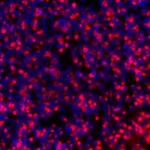
Paul P. Liu, M.D., Ph.D.
Senior Investigator
Translational and Functional Genomics Branch
NHGRI
Research Topics
Dr. Liu's laboratory investigates the molecular mechanisms of leukemia, with the long-term goal of translating research findings to improved clinical practices, including better diagnosis and treatment of leukemia and related hematological diseases. A group of diseases that strikes approximately 43,000 Americans each year, leukemias are frequently associated with chromosome abnormalities such as translocations, inversions and deletions. Two genes, CBFB and RUNX1, which encode proteins (CBFb and RUNX1, respectively) that form a dimer for DNA binding and gene expression regulation, are frequent targets of such chromosome abnormalities. Most of Dr. Liu's work focuses on these two genes and the core binding factor (CBF) leukemia, a subset of leukemia caused by chromosome abnormalities in these two genes. In addition, Dr. Liu has a natural history study at the NIH Clinical Center for patients with inherited RUNX1 mutations.
One form of CBF leukemia is associated with an inversion of chromosome 16. Dr. Liu found that this inversion generates a fusion gene between CBFB and MYH11, the gene encoding smooth muscle myosin heavy chain (SMMHC) (Liu et al., Science 1993). To study the fusion gene CBFB-MYH11, Dr. Liu's group generated a knock-in mouse model, which demonstrated that CBFB-MYH11 blocks normal hematopoiesis through dominant repression of Cbfb and Runx1 (Castilla et al., Cell 1996). Using the Cbfb-MYH11 knock-in mice (in which human MYH11 was inserted into mouse Cbfb to recreate the leukemia fusion gene), they demonstrated that CBFB-MYH11 is necessary but not sufficient for leukemogenesis (Castilla et al., Nature Genetics 1999). Dr. Liu's group identified cooperating genetic changes for leukemogenesis with a retroviral insertional mutagenesis approach (Castilla et al., PNAS 2004), and demonstrated that the fusion protein CBFβ-SMMHC blocks lymphoid differentiation, which may explain how the fusion protein only causes myeloid leukemia (Zhao et al., Blood 2007). More recently, Dr. Liu's group made the novel observation that Cbfb-MYH11 induces acute myeloid leukemia (AML) without dominant repression of Runx1, which was previously believed to be the only function of this fusion gene (Kamikubo et al., Cancer Cell 2010). They also identified Cbfb-MYH11 target genes during leukemia development by microarray analysis with cells from Cbfb-MYH11 knock-in mice, and identified leukemia-initiating cells using these new targets (Hyde et al., Blood 2010). With a clinically relevant transgenic mouse model, they demonstrated leukemogenic cooperation between Cbfb-MYH11 and mutationally activated KIT, which are frequently found in human AML cases with chromosome 16 inversion (Zhao et al., Blood 2012). Current and future efforts in Dr. Liu's lab include more functional studies of CBFβ-SMMHC with novel transgenic mouse models.
The zebrafish is a useful model for studying embryonic development and is easily amenable to large-scale genetic studies. Dr. Liu's group, with the help of the NHGRI Zebrafish Core, headed by Dr. Raman Sood, has used zebrafish to study the roles of several transcription factor genes in hematopoiesis, such as runx1, cbfb, and gata1 (Blake et al., Blood 2000; Lyons et al., PNAS 2002, and Sood et al., Blood 2010). Using a positional cloning/candidate gene approach, they identified a non-sense mutation in gata1 as the cause for a zebrafish mutant with a "bloodless" phenotype (Lyons et al., PNAS2002). As the first gata1 mutation identified in the zebrafish, this finding demonstrated significant functional conservation between mammalian and zebrafish hematopoiesis. Using a high-throughput reverse genetic screening system they generated a fish line carrying a truncation mutation in runx1, which led to discoveries of novel functions of the gene during hematopoiesis (Sood et al., Blood 2010). Dr. Liu's group also generated fish lines with novel mutations in gata1, which uncovered differential roles of gata1 between primitive and definitive stages of hematopoiesis (Belele et al., Blood 2009). More recently Dr. Liu's lab has generated fish lines with null mutations in cbfb and made novel findings regarding its role in hematopoietic stem cell production (Bresciani, Blood in press). Overall the zebrafish has proven to be an excellent model for dissecting the genetic control of early hematopoiesis, especially the formation of hematopoietic stem cells, from fresh angles and in great detail.
Germline mutations in RUNX1 cause familial platelet disorder with associated myeloid malignancies (FPDMM, or simply FPD), an autosomal dominant disease. Patients with this disorder have defective megakaryocytic development, low platelet counts, and defective platelet functions. FPDMM patients have a life-long risk of hematopoietic malignancies, with variable clinical presentation and disease penetrance among families with different germline mutations, and even between affected individuals within a single family. Currently there are no good biomarkers or easy assays to predict disease outcome, and there have been no systematic studies of FPD as a disease. To tackle these problem, we launched a RUNX1 longitudinal natural history study at the NIH Clinical Center in early 2019.
- Protocol Details: Longitudinal Studies of Patient with FPDMM [clinicalstudies.info.nih.gov]
- Longitudinal Studies of Patient With FPDMM [clinicaltrials.gov]
The purpose of this study is to conduct dedicated, systematic, and long-term clinical research of patients with germline RUNX1 mutations in order to achieve better understanding of the disease progression and underlying mechanisms, which will lead to better clinical management and hopefully develop new therapies. Those interested in the study may contact us at fpd.clinic@nih.gov.
Biography
Dr. Liu received his medical degree and residency training in internal medicine in Beijing, China. He then earned his Ph.D. in human genetics from the University of Texas M.D. Anderson Cancer Center in Houston. He received his postdoctoral research training at the University of Michigan before moving in 1993 to NIH's National Center for Human Genome Research, renamed the National Human Genome Research Institute (NHGRI) in 1995.
He has remained at NHGRI - appointed initially as a senior staff fellow, then as a tenure track investigator and since 2001 as a tenured senior investigator. Dr. Liu has been the head of the Oncogenesis and Development Section in NHGRI since 1995. In May 2011, Dr. Liu was appointed as the deputy scientific director of NHGRI. The main focus of Dr. Liu's research over the years has been the mechanism of leukemia development at the molecular level, using genetic and genomic approaches.
Dr. Liu discovered that a CBFB-MYH11 fusion gene is the product of chromosome 16 inversion, a common chromosome abnormality in human acute myeloid leukemia. Using animal models, Dr. Liu has illustrated the importance of CBFB-MYH11 for leukemia development, and how this fusion gene works. His group has also made important discoveries regarding the normal functions of several important leukemia genes.
More recently, Dr. Liu's lab has focused on developing targeted treatments for leukemia. Dr. Liu has received several honors for his achievements, including NIH Director's Award and elections to the American Society for Clinical Investigation and the Association of American Physicians.
Selected Publications
- Bresciani E, Carrington B, Yu K, Kim EM, Zhen T, Guzman VS, Broadbridge E, Bishop K, Kirby M, Harper U, Wincovitch S, Dell'Orso S, Sartorelli V, Sood R, Liu P. Redundant mechanisms driven independently by RUNX1 and GATA2 for hematopoietic development. Blood Adv. 2021;5(23):4949-4962.
- Yu K, Deuitch N, Merguerian M, Cunningham L, Davis J, Bresciani E, Diemer J, Andrews E, Young A, Donovan F, Sood R, Craft K, Chong S, Chandrasekharappa S, Mullikin J, Liu PP. Genomic landscape of patients with germline RUNX1 variants and familial platelet disorder with myeloid malignancy. Blood Adv. 2024;8(2):497-511.
- Zhen T, Cao Y, Ren G, Zhao L, Hyde RK, Lopez G, Feng D, Alemu L, Zhao K, Liu PP. RUNX1 and CBFβ-SMMHC transactivate target genes together in abnormal myeloid progenitors for leukemia development. Blood. 2020;136(21):2373-2385.
- Cunningham L, Merguerian M, Calvo KR, Davis J, Deuitch NT, Dulau-Florea A, Patel N, Yu K, Sacco K, Bhattacharya S, Passi M, Ozkaya N, De Leon S, Chong S, Craft K, Diemer J, Bresciani E, O'Brien K, Andrews EJ, Park N, Hathaway L, Cowen EW, Heller T, Ryan K, Barochia A, Nghiem K, Niemela J, Rosenzweig S, Young DJ, Frischmeyer-Guerrerio PA, Braylan R, Liu PP. Natural history study of patients with familial platelet disorder with associated myeloid malignancy. Blood. 2023;142(25):2146-2158.
Related Scientific Focus Areas
This page was last updated on Monday, November 24, 2025




